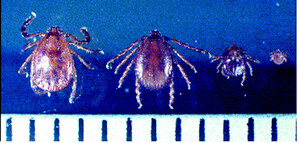hankyoreh
Links to other country sites 다른 나라 사이트 링크
First confirmed death from virus contracted by tick bite

By Kim Yang-joong, medical correspondent
After reported cases in China and Japan, the first death after a bite by a virus-carrying tick has been confirmed in South Korea. Based on a review of research carried out in China, where the disease was first discovered in 2009, the South Korean government and the academic community believe that the fatality rate of the tick-borne virus is 6%.

The Korean Centers for Disease Control and Prevention (KCDC) reported on May 21 that Seoul National University Hospital recently ran another test on the blood of a patient who had died after contracting a virus in Aug. 2012. This test showed that the patient had been infected with the SFTS virus, the KDCD said. SFTS stands for severe fever with thrombocytopenia syndrome (a medical condition in which there are extremely low platelet levels in the blood).
The deceased was a woman in her 60s who had been living in Gangwon Province. She was bitten by a tick while working in her garden in July 2012. About a month later, when she began experiencing a high fever and diarrhea and the tick bite started swelling, she checked into a local hospital. Her high fever showed no signs of abating, and she was transferred to Seoul National University Hospital, where she passed away four days later.
The doctors who had been treating her had not been able to identify the cause of the disease. They had suspected it might be some kind of fever-causing disease such as trombiculiasis or hemorrhagic fever with renal syndrome (HFRS), but the tests for these all showed up negative.
Tests were run on the bodies of five people who were suspected of being infected with the SFTS virus, the KCDC reported. These five had complained of high fevers, but doctors had been unable to determine what was causing the fevers. Of the five, only the woman from Gangwon Province was confirmed to have been infected with the virus.
DNA traces from the virus were also found in a recently deceased patient from Jeju Island. The case was suspicious to doctors because the patient’s symptoms had been similar to those caused by SFTS, the KCDC said.
It is now still impossible to make a definite diagnosis, but it is very likely that the patient was suffering from SFTS. Kim Yeong-taek, head of the infectious disease division at the KCDC, said that the tests results would be available before long.
Three of the other four cases that medical institutions had reported to the KCDC on the suspicion that they might be SFTS were confirmed to not be SFTS. In the other case, the fact that the symptoms were different led the KCDC to conclude it was a different disease.
“The media have been referring to this as a ‘killer tick,’ but that’s not really an accurate expression,” Kim said. “We believe that the mortality rate for the disease is around 6%, which is similar to the hemorrhagic fever with renal syndrome (HFRS) that is caused by viruses carried by field mice.”
“The tick that carries the virus in question is the Haemaphysalis longicornis was discovered in South Korea around 30 years ago,” said Oh Myeong-don, a doctor of infectious disease and internal medicine at Seoul National University Hospital. “A lot of research has been conducted into the issue in China.
"The reason the media was reporting that the mortality rate of the disease was 30% is that at first they were only able to find the most serious cases. But now reports have also been made of people who recovered on their own after being infected and people who only had mild symptoms, which has brought the mortality rate down to 6%," Oh said.
"While there is no reason to be overly concerned about the disease, it is still a good idea to make sure you don‘t get bitten by ticks."
Please direct questions or comments to [english@hani.co.kr]

Editorial・opinion
![[Editorial] Penalties for airing allegations against Korea’s first lady endanger free press [Editorial] Penalties for airing allegations against Korea’s first lady endanger free press](https://flexible.img.hani.co.kr/flexible/normal/500/300/imgdb/original/2024/0502/1817146398095106.jpg) [Editorial] Penalties for airing allegations against Korea’s first lady endanger free press
[Editorial] Penalties for airing allegations against Korea’s first lady endanger free press![[Editorial] Yoon must halt procurement of SM-3 interceptor missiles [Editorial] Yoon must halt procurement of SM-3 interceptor missiles](https://flexible.img.hani.co.kr/flexible/normal/500/300/imgdb/child/2024/0501/17145495551605_1717145495195344.jpg) [Editorial] Yoon must halt procurement of SM-3 interceptor missiles
[Editorial] Yoon must halt procurement of SM-3 interceptor missiles- [Guest essay] Maybe Korea’s rapid population decline is an opportunity, not a crisis
- [Column] Can Yoon steer diplomacy with Russia, China back on track?
- [Column] Season 2 of special prosecutor probe may be coming to Korea soon
- [Column] Park Geun-hye déjà vu in Yoon Suk-yeol
- [Editorial] New weight of N. Korea’s nuclear threats makes dialogue all the more urgent
- [Guest essay] The real reason Korea’s new right wants to dub Rhee a founding father
- [Column] ‘Choson’: Is it time we start referring to N. Korea in its own terms?
- [Editorial] Japan’s rewriting of history with Korea has gone too far
Most viewed articles
- 1[Editorial] Penalties for airing allegations against Korea’s first lady endanger free press
- 2Months and months of overdue wages are pushing migrant workers in Korea into debt
- 3In rejecting statute of limitations defense in massacre case, Korean court faces up to Vietnam War a
- 4Historic court ruling recognizes Korean state culpability for massacre in Vietnam
- 5“Those souls can rest now”: Vietnam massacre survivor reacts to Korean court win
- 6[Editorial] Verdict on Korea’s massacre in Vietnam a first step in atonement
- 7Ruling on Korean atrocity in Vietnam comes 23 years after Hankyoreh 21’s exposé
- 81 in 3 S. Korean security experts support nuclear armament, CSIS finds
- 9[Interview] Continuing the fight for victims of civilian massacres during Vietnam War
- 10Korea’s atrocities in Vietnam, in the words of those who saw and survived them